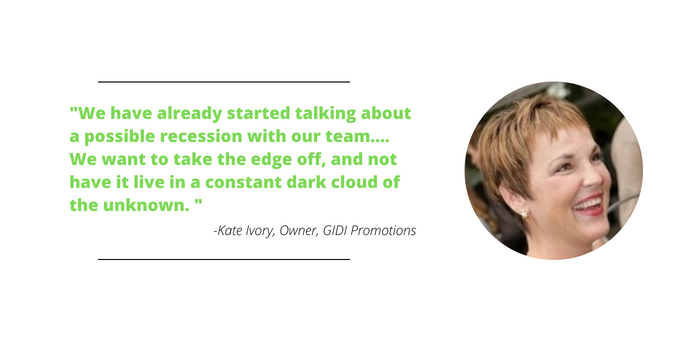10 Steps To Recession-Proofing Your Promotional Products Business

You’ve developed a vital muscle over these pandemic years, probably the most important muscle a business can flex: the muscle of resilience.
Distributors and suppliers faced challenges too extreme to even imagine prior to the pandemic.
But post-pandemic, you’re still standing with battle scars and wins to prove it all.
So, despite the ominous news making headlines right now—inflation, recession, the stock market—know that you have developed a super-strength that prepares you for whatever may come. For all its tragedy, the pandemic at least taught us how to adapt and survive, which is why news of a potential recession shouldn’t paralyze us into indecision but inspire us to action.
According to MarketWatch, back in January, 18% of polled economists predicted a recession. As of June 19th, that likelihood jumped to 44%. Some say we’re already in a recession; others say the warning signs have slowed. And if you want more mind-boggling volleys of opposing opinions, see what economists on both sides of the debate predict. And regarding predictions in general, watching the volatility of the stock market makes us dredge out Paul Samuelson’s famous quip that the stock market has predicted nine of the past five recessions. (In a bear market, like hiking the Appalachians, bear news travels fast).
Regardless of whether a recession is imminent, recession-proofing your business is not merely a survival tactic, it’s just good business.

These practices ensure the vitality of your ops, whether in good times or bad. Putting these practices into your weekly discipline now will sharpen your focus and tighten your grip on your operation should there be an economic downturn.
Here are 10 things you can do now to not only prepare for a recession, but strengthen your outlook, accelerate profitability, and grow, come rain or shine.
No. 1: Double Down On Sales And Marketing
If you have a weak business development plan, now’s the time to accelerate not decelerate investments in business development. Money flooded the market during the pandemic, and we (like many industries) are possibly oversaturated with demand. In flood times, salespeople tend to let new business development lax because they are struggling to keep up, but we can’t wait until our inboxes and calendars to dry up; invest now to reap the reward three, six, nine months from now.
Thriving in tough economic times is a combination of both defensive and offensive moves.
No. 2: Refine Your Customer List
Know who your top clients are by order of revenue and profit. It helps to know which clients mean the most to your bottom line and it’s likely that 80% of your revenue is derived from 20% of your clients. Do you know the VIPs in your client list? (Not the people who contact you the most but the companies whose revenue drives your profitability). Are you consolidated in only one or two industries/verticles?
Can you diversify your book of business? And mostly: Are you providing high-touch and high-service through a steady stream of new ideas to your top clients? When a recession hits, often, companies will consolidate vendors: You want to be at the top of that essential list if consolidation comes. Moreover, you want to help your clients get ahead of recessionary reactionary measures by helping them invest (more) in their own sales and marketing now.

No. 3: Analyze Your Strengths And Weaknesses
Reviewing your team and analyzing their strengths is not a step toward wholesale overhead reduction; you want to make sure every team member is functioning in a role that drives the business forward. Bain & Company called this “restructuring costs without cutting muscle.” One company actually increased its workforce by 10% in a recession through a restructuring process. By analyzing their strengths and underperforming categories, they were able to put amazing talent to work in other areas of the business and their post-recession growth soared.
No. 4: Know Your Numbers, Then Act On Them
If we asked you right now what your EBITDA is, could you say? And if not EBITDA, perhaps your total YTD sales figures, operating expenses, margin, and net profit? And if you’re a salesperson, can you name your YTD revenue and average margin for your top three clients?
A savvy promo pro not only knows their numbers, but understands how these fluctuate within the rhythm of their business. Knowing is only half-wisdom, the other half is acting on what you know. Example: If your average margin for a high-demand client is lagging, or if sales are declining with that client and you haven’t addressed it yet, now’s a great time to shore it up. Know your numbers and act on them.
No. 5: Reign In Receivables
It’s not a draconian move; sharpening your collection skills now is simply good business. If you have clients who are late in owing you money, now is the time to collect. In boom times, we get lax with receivables because projects are coming in fast, but the downstream effect of a relaxed attitude toward collections is dangerous water. Keep receivables tight and develop a process to review outstanding accounts regularly. Eight-two percent of businesses fail because of cash flow issues, often due to not paying close enough attention to margin, expenses, and receivables. And if you’ve grown comfortable with offering longer terms to clients, now is the time to consider reducing terms that might be a tad too generous.
In boom times, we get lax with receivables because projects are coming in fast, but the downstream effect of a relaxed attitude toward collections is dangerous water. Keep receivables tight and develop a process to review outstanding accounts regularly. Eight-two percent of businesses fail because of cash flow issues, often due to not paying close enough attention to margin, expenses, and receivables. And if you’ve grown comfortable with offering longer terms to clients, now is the time to consider reducing terms that might be a tad too generous.
No. 6: Know Your Cash Buffer
JP Morgan Chase produced a massive research report surveying over 600,000 small businesses and discovered that the average number of days a small business could pay out of its cash reserve is about one month.
On average, businesses are substantially more resilient if they hold a reserve of 62 days or more. Question for you: If inflows slow (i.e., sales decline or drop precipitously) how many cash buffer days do you have? Knowing your cash buffer helps you plan your cash flow in the event of an emergency, and it helps you think through the next tip.
No. 7: If You Need It, Secure Additional Financing Now
If your business has rebounded post-pandemic and you’ve experienced a growing season, it might be possible you’re sitting on a decision to increase your line of credit. Increasing access to credit can be a lifeline in volatile situations (as we’ve all learned painstakingly through the pandemic). According to Kiplinger, the average recession (post-WWII) lasts 11 months: Review your cash, your line of credit, and prepare contingency options now.
No. 8: Invest In Tech
Investing in technology consolidates your business, and makes you lean. Becoming agile is one of the smartest moves you can make to prepare for a downturn.
Efficient tech levels the playing field, and those that invest in infrastructure efficiencies prior to economic hardship end up more profitable during a recession; they roar out of a recession due to efficiencies gained. Particularly with companies who have bloated infrastructures, or archaic processes, investing in tech helps create a lean, agile operating team and allows you to focus on the most important thing in your world: growth. No. 9: Talk To Your Team
No. 9: Talk To Your Team
Sticking your head in the sand is not how smart leaders deal with bad financial news in the headlines. Kate Ivory, the owner of GIDI Promotions, has been through a few recessions and shared this tip, “Take care of the people you have. We have already started talking about a possible recession with our team. Especially if you are a small business, they may wonder if they will have a job. We want to take the edge off, and not have it live in a constant dark cloud of the unknown.
“Stop the water cooler talk if possible. Be open with your team and engage them in the conversation.”
Talking with your team about potentialities does not create a negative atmosphere unless you let it. By opening up the topic, you enlist their brilliant minds in solving a potential problem, not hiding from one that is painfully everywhere in the news. You’ve hired a brain trust in your team: Use it.
No. 10: Forecast Financial Scenarios
Bain calls this “stress-testing the P&L and balance sheet.” Model scenarios based on both growth and loss. Model cutting unnecessary expenses. Model declines in growth. Model increases in growth. Model tech investments contrasted against a bloated payroll. Modeling out scenarios helps you paint a picture with numbers. It allows you to think through contingency plans should you ever need them, and doing so offers you some assurance that you have—if even the faintest—an idea of a plan.
***
Finally, and above all: Remain optimistic and be bold. Boldness triggers purposeful action.
According to Bain, companies that ranked among the eventual winners through a recession moved deliberately to capture opportunities before the recession. “While they focused intensively on cost transformation, they also looked beyond cost. Think of a recession as a sharp curve on an auto racetrack (which is the best place to pass competitors, but requires more skill than straightaways). The best drivers apply the brakes just ahead of the curve (they take out excess costs), they turn hard toward the apex of the curve (identify the short list of projects that will form the next business model), and accelerate hard out of the curve (spend and hire before markets have rebounded).”
Winning companies behave differently before a recession, and eventually they roar out of one far ahead of the competition.
And a little preparedness will help prevent our industry from forever circumnavigating around that dreaded word “pivot” again.
Fortune—and a little preparedness now—favors the bold.
This article is brought to you by commonsku, the work-from-anywhere platform that powers your connected workflow enabling you to process more orders and dramatically grow your sales. To learn more visit commonsku.com.

